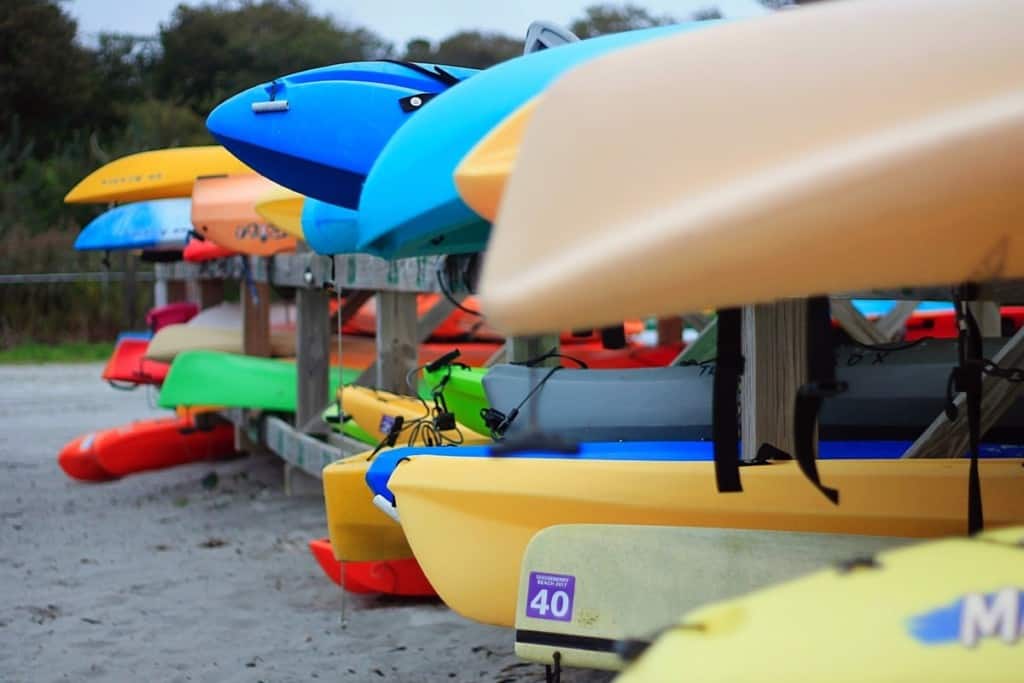
It was a fun day out on the water. You caught your fill. Time to haul that heavy ‘ole kayak out of the water, transport it home and then find a place to store it till it’s ready for its next outing. Thing is, you shouldn’t just throw your kayak on the side of the house or out in the open in the yard.
A kayak is an investment, you should learn to store it so that it will last.
To properly store a fishing kayak, you must remove all fishing gear from your kayak. Clean your equipment. Carefully store kayak upside down with support evenly distributed as not to warp the boat. The boat can be either suspended by straps or on a rack indoors or outside on the ground on top of two 2×4’s and under cover to protect from sun and rain.
It may seem simple, but if your fishing kayak is not stored properly it may end up warped and discolored or even worse, with a damaged hull. A damaged kayak is never fun, but with a few simple changes on how you store your fishing kayak you can have a boat that can last you a lifetime.
Proper Storage Begins When Your Just Out of the Water
Once you set foot back on land, consideration should be made to properly care for and store your kayak. If I have a kayak trolley with me, I will wheel my kayak and all its fishing gear back to my vehicle and unpack there. If I’m carrying my kayak, then I’m going to unpack my fishing gear by the shore.
I like to pack light. Two to three fishing poles. A small box of tackle and other equipment that fits in my milk crate. A fish finder, camera mount, anchor, net, and water and snacks for me. That’s it. Pretty much all of that gear can be stowed in my milk crate with rods, net and anchor in the holders installed on my crate. I can carry this back to my vehicle in one trip.
As an added benefit, all my fishing gear is already stored in the milk crate ready for my next outing. It takes up just a little spot on a shelf in my shed. I do take my poles out, clean and store them in PVC tubes to protect them better.
Once all that is in the car I can carry the kayak over my head back to my vehicle. At this point I still have my seat on the kayak and paddle in its paddle holder. If there is a water source nearby I will try to hose off my boat. Keeping it clean from the start is the way to go.
At the car I will remove the seat and paddle and put the kayak on the racks or back of the truck, depending on what car I was using that day. It’s finally time to head home.
Where to Store your Kayak and Fishing Gear
Ahh. Finally home. But we’re not ready to kick off the shoes and relax. It’s time to put everything away. Don’t wait, you’ll thank yourself later.
If you’re like many kayakers, you’ll just take your boat off the racks and place it in the yard, facing up and exposed to the sun and rain. This is a recipe for disaster. The UV light from the sun will slowly break down the materials your boat is made from. By storing face up, the rain can accumulate, leaving staining and breeding grounds for mosquitos.
Maybe you bring your kayak indoors but just leave it on the ground where other junk gets piled on top of it or you leave it resting vertically haphazardly in the corner of the garage. You are inviting a catastrophe.
So where do you store your kayak?
If you have space, indoors is ideal. Placed horizontally on a rack or suspended from the ceiling with proper support, out of the way of potential hazards, makes a kayak stored indoors well protected.
You can store your kayak vertically on its TAIL, but you must make sure that it is supported from falling over.
For many of us, there just isn’t a spot for your kayak indoors, so someplace outside is the only option. I will look for any areas that are protected from the elements and are not in high trafficked areas. Under a deck or roof overhang works, but proper care should be made to store the kayak correctly.
We also want to make sure the kayak is safe from theft. The best option would be to store it indoors where it could be locked up, but if it has to be stored outside, try to make sure it is in a hidden spot, chained up if possible.
Your fishing gear should always be stored inside. Find a nice corner or shelf somewhere in a garage, shed or in the house and carefully store your fishing gear where it will stay in good shape. Hang your rods or store them in PVC tubes. Make sure your reels are clean and store them where they will be kept safe as well.
How to Store Kayak and Fishing Gear Efficiently
We’ve found a place to store our kayak and gear, now it’s time to put it all away. Whether storing your kayak indoors or outdoors, there are a few factors to consider that will make for safe storage.
STORING YOUR KAYAK INDOORS
If you want to go with the best way to store your kayak, building a rack specifically for your kayak would be the way to go. I would build it so that there is support under the boat, from the front scupper hole to the rear scupper hole.
A simple way to accomplish this is to measure the distance between the two scupper holes in the front of the kayak. Most are between 8”-10”. Drill 2 PVC pipes that distance apart onto your rack and rest the bottom of your kayak on those pipes. The PVC helps the kayak slide in more smoothly.
If a rack takes up too much room, you can suspend your fishing kayak from the wall or ceiling using straps. Cinch straps work well for this. I will have my kayak on its side and use 3 straps, one a foot back from the nose, at the midsection and a foot from the tail. This will give your kayak proper support and keep it from warping out of shape.
An easy hack for the strap method would be to get a long strap with a hook on one end. Have a corresponding hook secured to a stud on the wall or ceiling. Wrap the strap around the kayak, hook both hooks together and pull the strap tight to lift the kayak into place. Do the nose and tail first and then pull tight the midsection to the point that it supports the kayak along with the two other supports.
The last method for storing indoors would be to stand it up on its tail vertically. The tail is stronger than the nose and if resting on support like a mat or piece of carpet, storing vertically on the tail is a great way to store your kayak. It is important that it is supported from falling over. A simple strap across the kayak secured to the wall will keep your kayak from tipping over.
STORING YOUR KAYAK OUTDOORS
Storing a kayak outside would not be my first choice, but it can be done. After finding a secure, location out of the elements, building a rack similar to the one you would build indoors would be my first choice for storing a kayak.
Having your kayak securely placed in a rack, off the ground, will go far in prolonging the life of your kayak. But if you have to, you can store it on the ground.
When storing a kayak on the ground, I would place it deck down across 2×4’s placed at the nose, midsection and tail. You may need to stack a couple of 2×4’s for the midsection to give it proper support.
By storing upside down, the rainwater will not collect in the boat. The bottom of the kayak is also the strongest part, so storing upside down will help protect your kayak in the event that anything should fall on it.
Your kayak can be stored vertically outside under an eave. Just make sure it is tail down, resting on some padding and securely fastened from tipping over.
For more protection, wrap your kayak in a heavy-duty tarp. This will keep the sun and rain off your kayak if you are not able to find a more secure place for your kayak.
How to Maintain Your Fishing Kayak
Proper maintenance of your fishing kayak will keep it lasting for a lifetime. Proper storage is the number one way to maintain your kayak, but sometimes you need to do a little extra to keep it in tip-top shape.
After every paddle, I make sure I wash my kayak down with fresh water. Any saltwater, dirt or plant materials left on your kayak will slowly begin to breakdown the materials of your kayak. It’s an easy thing to do and should not be overlooked.
From time to time I like to make deeper inspections. I check all the attachments to my kayak, whether they be rod mounts or drain plug. If a screw is loose or there is a leak, I make sure to address the issue right away. Any moving parts? They’re getting oil. If something needs a deeper cleaning I will inspect it.
Once a year or so, you can treat your kayak with 303 Aerospace Protectant. It’s not necessary by any means, but if you want to keep your kayak “conditioned”, then massaging a little bit of this product will keep your kayak looking new.
Now you know how to store your fishing kayak. You have no excuse not to protect your investment so that it will last a lifetime. The better shape our equipment is, the more time we get on the water. See you out there.
